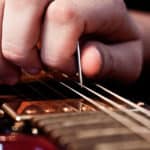A lot of people often don’t learn instruments because they say it’s too hard. Some even argue that some instruments are harder than others.
Today, we’ll look at how hard guitar is to learn, and the answer might surprise you.
Learning guitar, like any other craft or skill, gets more difficult the deeper you go into it. If you want to learn the basics of guitar, it’s not very difficult and might only take you a few months. If you want to master guitar, it can be a long journey in many aspects.
Guitar as an instrument has some differences to it as far as learning when compared to other instruments so obviously, the approach would be different.
Let’s take a look at how those dynamics affect learning the guitar below.
Is the guitar a hard instrument to learn?
Hard compared to what?
Let’s take a look at some of the basic skills required to get to grips with playing guitar and we’ll contrast them with another instrument like a piano:
- Basic posture
- Finger development for playing the frets
- Hand synchronicity; one for rhythm, one for notes
- Learning the notes of the neck, understanding the repeating notes
- Learning chord shapes and barre chords
- Learning scale patterns for lead guitar
- Learning advanced techniques like tapping, harmonics, and sweep picking
Now compare that with something like the piano (which I’ll admit, I’m not the best pianist, but the mechanics are similar):
- Basic Posture
- Finger development for playing keys
- Hand independence for playing poly-rhythms or base notes and treble notes
- Practicing scales
- Practicing chords and chord inversions
- Agility and accuracy
The main difference is the roles that your hands play between these two instruments.
In piano, both hands play notes and you can learn songs one hand at a time.
With guitar, your hands have to work together.
One hand acts as the hammer and the other presses the notes in time with the other hand. The right hand has to synchronize with the left hand, which is – to a degree- different from the piano.
With the piano, the hands still play in time to each other, but each hand can play notes without the need for the other.
Every guitar skill has to do with building on hand synchronicity at greater and greater speeds.
Then there is music theory and how it relates to using each instrument.
With guitar, many notes repeat on different strings.
Playing chords is also a matter of left hand (or right if it’s your less dominant hand) strength and competence.
So the main issue with the guitar is how coordinated your hands are in working together.
When you learn sweep picking or speed picking mechanics, that becomes more and more important.
How long would it take you to learn guitar?
It depends on how much you want to learn.
If you want to learn basic chords and some simple progressions – enough to cover modern songs as a rhythm player.
Probably only a few months, depending on how much you practice.
If you want to reach mastery that would be at a professional skill level, it would probably take you six to ten years and that’s with dedicated practice and a good teacher.
Why?
Because of diminishing returns and the growing complexity of what you need to grasp.
Learning a few notes and chord shapes is easy to grasp.
Learning the difference between modes and learning how to implement complex rhythms into songs while remaining in accurate timing is a little more difficult.
Many people struggle with playing triplets on 4/4 time, not to mention pentuplets (5 notes over time 4) and septuplets (7 notes over 4).
Do you need natural talent to learn guitar?
No.
You do not need “natural talent” to play guitar.
Some people might be more inclined to learn the guitar, they may pick it up more easily, but it doesn’t mean the guitar is only for them.
Anyone can learn to play the guitar, it just might take some more effort than others.
However, I strongly advise that you don’t waste time comparing yourself or your progress to that of others. You’ll do far better by focusing on your own development.
6 Hardest things about learning guitar
1. Hand positioning and proper posture
As simple as this may seem as a concept.
Posture and good hand positioning quickly go out of the window during practice and attempts at improving speed.
People often seek speed at the cost of accuracy and good technique.
Why I put hand positioning and proper posture here is because as you improve in skill and as your techniques grow, hand technique becomes more and more important.
The way you pick a string, the way you use your wrist, and the way your fingers are positioned over the frets all become more and more important.
2. High-speed alternate picking
What makes alternate picking difficult?
Well, it’s easy at 80 BPM, but how about 200 BPM?
There’s a concept in guitar picking called transition time and it refers to how long it takes for your hand to respond to your reflex to pick the string.
It refers to how well your hands work together.
The difficulty here is that few people ever practice improving their picking synchronicity and transition time.
So when they get faster, their timing goes out the window.
If you looked at your hand playing in slow motion, you’d see that either your picking hand hits the string first or your fretting hand and there’s this transition time or delay between the two matching up.
When you get faster, that time stays the same but the notes shorten, and so synchronicity suffers.
All you have to do is practice speeding up this transition time to improve it.
How?
By working on your transition speed.
Practice playing any set of notes, but play them slowly.
The only quick part of your playing is when you switch between notes, you should try to transition as quickly as possible, but let the note ring out.
3. Legato licks
Legato licks require playing notes without picking.
A lot of people enjoy this style, otherwise known as playing with only hammer-ons and pull-offs.
The challenging part of this technique is that you have to develop your left hand.
It all comes down to working on how accurately you hammer onto the frets and how you pull off from the string, hooking it so that the pull-off itself creates the sound.
Then it’s about practicing this until you can do it at high speeds.
That means, at a high speed, hammering your finger onto frets accurately and quickly hooking the string as you pull it off.
It all comes down to practice and muscle memory.
4. Sweep picking
Sweep picking is probably one of the cooler advanced techniques, but it all comes following the hand synchronicity in number two.
Your hands have to work together perfectly to sweep pick.
More than that, you’re not just working on one string, but your fingers have to stay in sync while going over different strings.
5. Advanced rhythms
We all know rhythms that look like this:
And we’ve probably played ones that look like this:
But what about stuff like this:
The difficulty with advanced rhythms is that people often struggle with transitioning between straight notes and odd meters in the same bar.
Rhythm plays a big role in music and as you advance in your skill, you’ll find that this can be quite a difficult aspect to grasp, but with a few tricks and practice, it becomes pretty manageable.
6. Polyrhythm and odd timing
Polyrhythm and weird timings (5/4 and 7/8) are most prevalent in metal genres, but they can be quite fun to learn.
The reason they’re challenging is that they go against our natural inclination for evenly-spaced timing.
We tend to like working in 2s, 4s, 6s, and so on, 3/4 timing is still manageable, but the 5 and 7 timing is very weird on the ears.
Poly-rhythms are when one member is playing a specific beat or timing and another is playing a different timing.
Like one member playing eighth notes while another plays 12th notes.
Can you learn guitar by yourself?
Many people have learned guitar by themselves.
The number of resources available to us today makes it not only possible but almost easy to learn guitar on your own.
The challenging part of learning guitar by yourself is knowing where to start.
Luckily, we have an article for that:
Go check it out.
4 tips to learn guitar faster
1. Be honest with yourself about where you’re at
You can’t make progress if you can’t assess where you are.
As a beginner, this may be difficult, but it can be as simple as saying “I want to learn to play chords and understand what keys are and how they work.”
Try to make it specific, yet straightforward.
If you just say to yourself “I want to be the best guitar player ever.”
Or
“I wanna play like van Halen.”
Then the questions have to follow: what defines a great guitarist and how did Van Halen play?
2. Take it step by step
Once you have established a goal, break it into chunks and start tackling it.
If you just want to learn how to play basic guitar and play chords, you can start looking at where you are and how to get there.
Asking yourself questions along the way such as:
- Does this align with my goal?
- Is this absolutely necessary to be able to do what I want?
- Is this an extra thing that I might like to learn but is ultimately a distraction at the moment?
You can find a lot of videos giving advice on how to begin your guitar journey.
I’ve linked some of the most useful ones I found below.
3. Work on your weak spots
As you grow in your guitar skill, you will inevitably find that you develop strong points and weak points depending on what you focus on most.
A great example is a musician who understands basic music theory and can play scale shapes really quickly and really accurately, but can’t compose their own music because they don’t understand how the notes interact.
Another example is someone who is really knowledgeable in music theory and has read all the literature but doesn’t have the skill to put it into real practice.
More applicable to the common guitar player is the small weak spots we have in our playing.
We might know some scales and be able to play at a relatively impressive speed, but our timing and accuracy are a little off.
There are many examples, but you should seek to know yours so you can work on them and become a more rounded musician.
4. Be diligent
Finally, the thing is easier to say than to do.
This all comes down to structuring your learning.
If you create a daily routine, diligence becomes a lot easier.
Will knowing how to play other instruments make learning guitar easier?
To a degree. All instruments work together to make music.
So if you’ve played drums, rhythm won’t be much of an issue for you in guitar.
If you’ve played piano, melody and music theory won’t be an issue.
The main difficulty between instruments is the difference in mechanics- in how you interact with the instrument.
The core of music remains the same, so you’ll always benefit from having known another instrument before.
Are there any disadvantages to learning guitar?
All instruments have some drawbacks. With guitar, it comes down to physical discomfort for the most part.
When learning guitar, you can expect to encounter some pains:
- Blisters on your fingers (they become callused and it gets better)
- Wrist pain (either due to poor technique, uncomfortable guitar size, or just muscle tiredness)
- Shoulder pain (guitars get heavy to hold and play for hours on end)
- RSI (repetitive strain injury) This is common for all instruments. If you practice too much, you’ll strain yourself
- Knee pain from standing on one leg too much, just shift weight occasionally
- Noise, especially electric guitars, but there’s a workaround for all of it
- Ear damage caused by the loud noise, simply wear ear plugs to help
- Most people prefer pop music over guitar skills, but that doesn’t matter anyway
The bottom line is that you shouldn’t over-train and you should watch out for any bad habits you might develop.
You can do this by either starting out with a teacher or by watching videos on good technique and then monitoring yourself.
You can video yourself playing to do this.
What kind of guitar is better for a beginner?
It depends on your goals and your age and size.
When you buy a guitar, you should test it out at the store before committing to it. Different guitars have slightly different shapes and sizes and some will suit you better.
Children should get smaller guitars, you get 1/4, 1/2, and 3/4 guitars.
If you’re looking to play acoustic guitar, get acoustic, if you’re looking to play electric guitar, just get an electric.
A lot of people think you should get an acoustic first, but I disagree. It’s just an extra step in my opinion.
How much music theory do you need to know to play guitar?
Also, depends on your goals.
If you’re interested in the basics of guitar, learning the different keys and the chords in them along with the major scale will do you just fine.
If you want to master guitar and be a great musician that makes your own music, you’ll need to delve into many aspects of music theory.
The thing that makes guitar difficult is how limitless it seems to be in its capacity for creative expression.
You can make a guitar squeal, you can make it chug, you can make it do a lot of things a piano can’t do. It’s almost only limited by your imagination.

Hello there, my name is Ramiro and I’ve been playing guitar for almost 20 years. I’m obsessed with everything gear-related and I thought it might be worth sharing it. From guitars, pedals, amps, and synths to studio gear and production tips, I hope you find what I post here useful, and I’ll try my best to keep it entertaining also.





